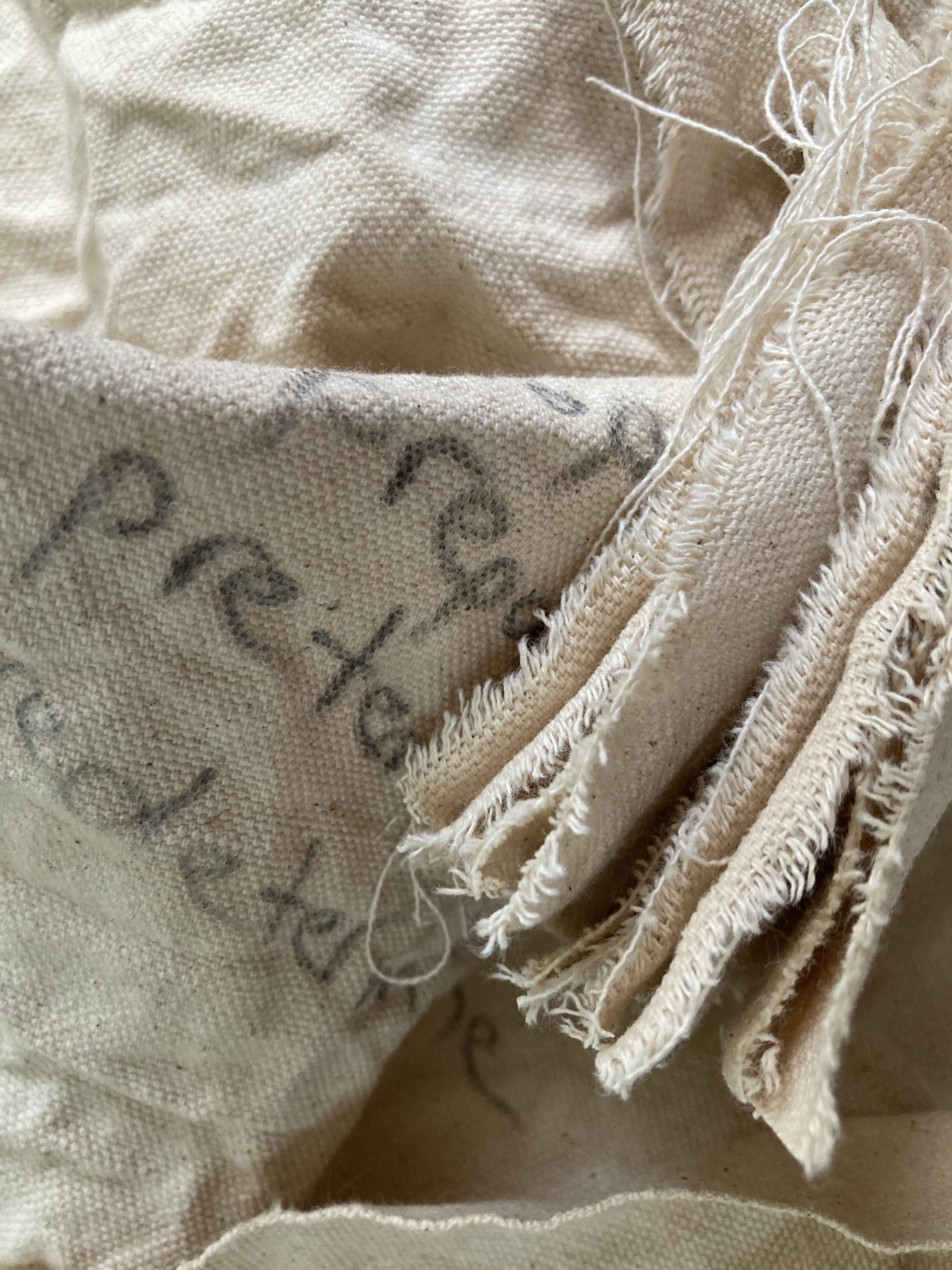My practice is firmly planted in my relationship with materials. This is underpinned by what practice-based researcher Barbara Bolt describes as, a ‘co-collaborative’ and ‘co-responsible’ way of making art, where “art is a material practice and the materiality of matter lies at the core of creative practice” [1]. I am drawn to materials that have transformative and malleable qualities that are typically reused, recycled or readily available, and capture my attention in relation to a current feeling or inquiry. Petra Lange-Bernt, editor of Materiality (2015) proposes materials as “wilful actors and agents within artistic processes” [2]. I love this description as it speaks to the character traits of materials as active participants in a process that helps to spark ideas, aid navigation and present technical challenges to overcome. Using my body as co-creator I typically activate a creative process by physically moving with a core material such as a run of rolled canvas. I bring in other materials like paint, water, glue and fibres as agitators, working together; entwining, creasing, layering the materials in a spontaneous and improvisational way. My camera has recently emerged as a ‘co-responsible’ element providing process footage to further explore the materiality of light, sound and movement apparent in the making. When my process is complete what remains is the residue of the making, like the exoskeleton of a cicada, left behind by its maker.
In terms of art historical context there are aspects that refer to US-based Minimalist and Post-Minimalist approaches to sculpture (1960 – 1990), which predominantly relate to how I perceive the art I make, to exist in an exhibition space. Here there is consideration of gravity, and proportion of works in relation to the body of the maker, and the body of the beholder. There is an intention for art to be something participatory, and to be actively explored in its relationship to the space it occupies. Adjacent to this, aspects of my practice embrace expression and emotion in the process, which sit outside of traditionally accepted minimalist ideas. I’m especially influenced by Lynda Benglis (American, b. 1941), and her very present painterly sculptures that hang off the wall and run across the floor. Her body-sized knots, each a portrait of a ‘person’ stalled, twisted, contorted and on the wall. I enjoy the provocation within the experience of a Benglis work. Eva Hesse (American, 1936-1970) is another artist of interest, her work seems to capture the emotional resonances of materials. Referring specifically to her relief sculptures and serial works such as Repetition Nineteen III (1968), these pieces emanate a feeling of strength and vulnerability in their materiality. What I appreciate most in Hesse’s work is the individual handling and unique shaping of her pieces that seem to hold a trace of the maker in each piece. I also look to artists such as Abstract Expressionist Helen Frankenthaler (American, b. 1928) and Gretchen Albrecht (New Zealand, b. 1943) who so magnificently model an authentic and tender relationship with materiality and colour. I have recently been motivated by the content of artist Sol LeWitt’s letter to artist Eva Hesse – DO! (1965) written during a time of personal crisis for Hesse, and Richard Serra’s Verb List Compilation: Actions to Relate to Oneself (1967-1968). In response to these texts, I am playing with the use of ‘verbs’ as co-responsible elements in the production of my work. I’m curious about the potency of the verb as an action, state, or occurrence, when aligned with a work as a title, and how this might contribute to a works reception.
In terms of personal context impacting upon processes of making, my arm-span as a measure of my body in space became amplified during New Zealand’s lockdown period of COVID-19, Alert Level 4. In response to the enforced limitations of space and of contact during this time, I began playing with collapsible cotton runs that matched my arm-span, allowing me to stretch the material and my limbs to the perimeter of my world. The unique properties of this adaptable and strong fibre extended into other sinuous material such as cord and rope. These runs of fibrous material have an umbilical-like feel for me that make me think about: connection and attachment, nurturance and sustenance, blood flow and lifeforce, enlivened during the process of making. This material and the way it guided my making and discoveries is exemplary of the ‘co-collaborative’ and improvisational nature of my broader practice.
- Estelle Barrett and Barbara Bolt, Carnal knowledge: Towards a ‘New Materialism’ Through The Arts (London: I.B. Tauris, 2013).
- Petra Lange-Berndt, Materiality (The MIT Press, 2015), p.18.
